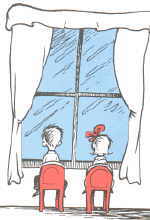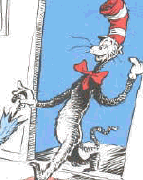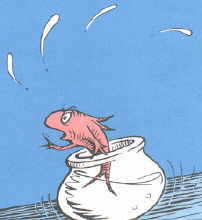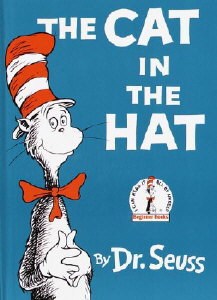reading deeply
Little Red Riding Hood is a female with lax morals? Her counterpart Little Red Cap has an Oedipal (actually an Elektra) complex? The wolf and hunter represent father as seducer and protector?
Bruno Bettleheim's The Uses of Enchantment , a Freudian interpretation of folk and fairy tales, seems a bit far-fetched. We can't imagine that the orginaters of these tales would have dreamed of such stuff or even if they did that a child (or most adults) would come to any of these conclusions.
Perhaps that is not what Bettleheim is saying. He clearly favors Little Red Cap by the Brothers Grimm over Little Red Riding Hood by Charles Perrault because Red Cap's character is challenged, experiences difficulty, receives help, and eventually learns from her experience. Little Red Riding Hood simply disobeys and is destroyed because she failed to listen to Mommy and Daddy enough.
Little Red Cap learns, and the child listener/reader realizes that parents make rules for reasons; mistakes happen and (usually) are not fatal; kids can learn from their mistakes. The pattern is hopeful. The ending of the story, where "Little Red Riding Hood thought to herself, as long as I live, I will never by myself leave the path, to run into the wood, when my mother has forbidden me to do so," also suggests that children do grow and become more independent. Red Cap is not thinking that she will never leave the path again, she will just wait until it's not forbidden, when she is ready and is given more opportunity to make her own decisions.
Little Red Riding Hood is, in Bettleheim's view, just a cautionary tale. Like Frederich Hoffman's Struwelpeter and Roald Dahl's Charlie and the Chocolate Factory the story is a warning to kids saying, "If you mis-behave or fail to do EXACTLY what grown-ups tell you, you will be punished, perhaps even killed." A child might grow fearful but not more independent and responsible reading Perrault's story.
OK, that seems reasonable, but what about all of the psychological analysis that ties these stories to sexual development? Even though Bettleheim supplies his chain of reasoning, it seems a little silly to look at a children's story so deeply. Certainly no child will read "Little Red Cap" and say, "Hmmmm ... Red Cap is competing with her father's love and needs to kill off the more experienced competition, (figuratively) her mother."
But Bettleheim never says that a child WILL articulate this sophisticated and not-very-child-like notion. He DOES, however, suggest and fairly clearly demonstrate that the story does follow that pattern and COULD be interpreted psychologically, even if that was not the original storyteller's intent.
Just consider that there is, perhaps, room for several levels of interpretation. The stories are charming, whimsical, fantastic. They also seem to teach simple lessons about listening to parents, avoiding strangers, working as a team. They also seem to be open to psychological interpretation. The more logical interpretations a story can support, the richer the story (Note: here logical means that the conclusions can be supported by what is happening in the text of the stories).
As we look at a number children's (or any) literature, we shouldn't limit ourselves to one easy interpretation only. After all, as we develop, our understanding of our world and of art develops too. Alice's Adventures in Wonderland read at age 10 is a lot of fun, with talking animals and nonsense; the same book read in college seems to be much deeper--loaded with social and political commentary, math puzzles, language games, psychological images, etc. The book is the same; we have changed.
We do want to look at what the books on our reading list have to offer children (what do they teach? how do they offer escape?); we also want to explore what they suggest more subtly, on deeper levels. Truly rich childrens books can speak to us on many levels; they invite us to discover new things.
let's try it
Take, for example, Dr. Seuss's classic A Cat in the Hat (if you have not read A Cat in the Hat [???] then you ought to run out and get a copy and read it NOW!). The book helped spearhead a revolution in early readers. The author/illustrator moved away from the pedestrian Dick and Jane primers to give kids books with invention, humor, rhythm, rhyme ... fun! They are educationally sound--they have controlled vocabulary, repetition, context cues, etc. But they combine education with delight.
From a child's point of view the stories are active and musical. The drawings are primitive cartoons (Seuss admitted he never could draw realistically; it's good for him that he couldn't). The situations engage a child's imagination and offer escape.
But let's look a bit deeper. What, for example, does the story tell us about the time in which it was written?
 Well, for one thing, the two children in the story would probably be picked up by CPS nowadays; half a century ago, however, there doesn't seem to be much of a problem leaving the two youngsters home alone. It's true they seem placid and well-behaved; they are sitting quietly looking out the front window at the rain. Everything is calm, orderly, sleepy even. As a social document, the book suggests that parents in suburban 1957 were more secure in their neighborhoods. Crime was not as pervasive: kidnapping, gang wars, and drugs were not pandemic. More than likely a neighboring mom (there were not nearly so many women in the work force yet) was just a shout away.
Well, for one thing, the two children in the story would probably be picked up by CPS nowadays; half a century ago, however, there doesn't seem to be much of a problem leaving the two youngsters home alone. It's true they seem placid and well-behaved; they are sitting quietly looking out the front window at the rain. Everything is calm, orderly, sleepy even. As a social document, the book suggests that parents in suburban 1957 were more secure in their neighborhoods. Crime was not as pervasive: kidnapping, gang wars, and drugs were not pandemic. More than likely a neighboring mom (there were not nearly so many women in the work force yet) was just a shout away.
 Even still, one of the first things the kids do is to allow a stranger to barge into the house and talk them into doing things they know are not quite right. True, the stranger is a huge cat, but he's very human-like in his posture and talk. He's fast-talking and irresponsible, and he even in 1957 kids were told not to get into cars with stranger or let them into the house. The kids are not supervised, and, consequently, they're not acting the way they ought to. Still, there is no real sense of threat in the Cat. He's just mischievous. This is clearly a story from a different era in American history.
Even still, one of the first things the kids do is to allow a stranger to barge into the house and talk them into doing things they know are not quite right. True, the stranger is a huge cat, but he's very human-like in his posture and talk. He's fast-talking and irresponsible, and he even in 1957 kids were told not to get into cars with stranger or let them into the house. The kids are not supervised, and, consequently, they're not acting the way they ought to. Still, there is no real sense of threat in the Cat. He's just mischievous. This is clearly a story from a different era in American history.
 And what is the story saying about the psychology of kids left up to themselves? Much like Maurice Sendak's Where the Wild Things Are this book acknowledges that kids have vivid imaginations and powerful emotional urges. Sometimes they suppress the emotions; sometimes not. In any case, they seem to work through violence, destruction, assertion in their imaginations. It's hard to take Cat in the Hat literally (some of us do talk to our cats, but it's not quite the same as an upright cat juggling while standing on a ball and speaking in poetry). The urges reach their peak in the figures of Thing 1 and Thing 2. No doubt Bettleheim would have seen them as id figures--the animal nature that wants to break loose from the dreary social conventions that rule us most of the time.
And what is the story saying about the psychology of kids left up to themselves? Much like Maurice Sendak's Where the Wild Things Are this book acknowledges that kids have vivid imaginations and powerful emotional urges. Sometimes they suppress the emotions; sometimes not. In any case, they seem to work through violence, destruction, assertion in their imaginations. It's hard to take Cat in the Hat literally (some of us do talk to our cats, but it's not quite the same as an upright cat juggling while standing on a ball and speaking in poetry). The urges reach their peak in the figures of Thing 1 and Thing 2. No doubt Bettleheim would have seen them as id figures--the animal nature that wants to break loose from the dreary social conventions that rule us most of the time.
 And the talking fish (not unlike Jimminy Cricket in Disney's version of Pinocchio), is the super-ego, the higher functions, the conscience. He's constantly reminding the kids that this sort of mischief is not right, especially when mother has trusted them to take care of themselves. As a psychological piece, however, it only works when mother is not home. Like Max in Wild Things, the child's imaginative urges are internal. They are not approved by the adults, so they take place in the mind or in the room during time-outs. In the end, the kids in Cat in the Hat have the destructive playmates put back into the box; they need to have the house orderly again before the mother returns; the dreary, rainy day is back, and they are sitting quietly when the mother steps through the doorway.
And the talking fish (not unlike Jimminy Cricket in Disney's version of Pinocchio), is the super-ego, the higher functions, the conscience. He's constantly reminding the kids that this sort of mischief is not right, especially when mother has trusted them to take care of themselves. As a psychological piece, however, it only works when mother is not home. Like Max in Wild Things, the child's imaginative urges are internal. They are not approved by the adults, so they take place in the mind or in the room during time-outs. In the end, the kids in Cat in the Hat have the destructive playmates put back into the box; they need to have the house orderly again before the mother returns; the dreary, rainy day is back, and they are sitting quietly when the mother steps through the doorway.
And what should we make of the final question? The kids are wondering if they should tell their mother of their adventures (literally letting a stranger into the house or figuratively letting the wildest parts of their imaginations take over for a time). Seuss doesn't answer the question; instead, he invites the reader to think about what the right thing to do is. It is not the tight cautionary tale with a right answer. It allows us to think about social conventions, polite behavior, parental approval/disapproval, honesty vs. discretion. It's a rich story that works on many levels. And it STILL works many years after it was written.
That is the way we will be looking at the readings in this class.
:)

![[course schedule]](button31s.gif)
![[discussion questions]](button31q.gif)
![[lectures]](button31l.gif)
![[writing assignments]](button31p.gif)
![[readings]](button31r.gif)
![[home]](button31h.gif)